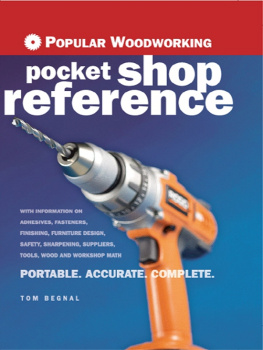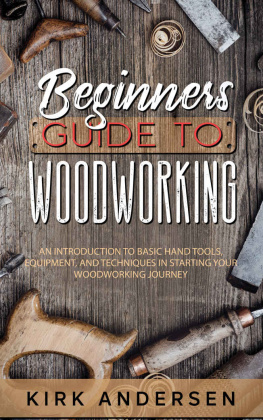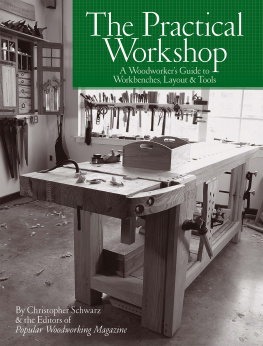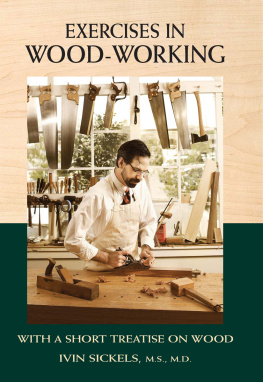 POPULAR WOODWORKING
POPULAR WOODWORKING
practical Shop
math PORTABLE. ACCURATE. COMPLETE. TOM BEGNAL  read this Important
read this Important
safety notice To prevent accidents, keep safety in mind while you work. Use the safety guards installed on power equipment; they are for your protection. When working on power equipment, keep fingers away from saw blades, wear safety goggles to prevent injuries from flying wood chips and sawdust, wear ear protectors, and consider installing a dust vacuum to reduce the amount of airborne sawdust in your woodshop.
Dont wear loose clothing, such as neckties or shirts with loose sleeves, or jewelry, such as rings, necklaces or bracelets, when working on power equipment. Tie back long hair to prevent it from getting caught in your equipment. People who are sensitive to certain chemicals should check the chemical content of any product before using it. The authors and editors who compiled this book have tried to make the contents as accurate and correct as possible. Plans, illustrations, photographs and text have been carefully checked. All instructions, plans and projects should be carefully read, studied and understood before beginning construction.
Due to the variability of local conditions, construction materials, skill levels, etc., neither the author nor Popular Woodworking Books assumes any responsibility for any accidents, injuries, damages or other losses incurred resulting from the material presented in this book. Prices listed for supplies and equipment were current at the time of publication and are subject to change. Glass shelving should have all edges polished and must be tempered. Untempered glass shelves may shatter and can cause serious bodily injury. Tempered shelves are very strong and if they break will just crumble, minimizing personal injury.
METRIC CONVERSION CHART
| to convert | to | multiply by |
| Inches | Centimeters | 2.54 |
| Centimeters | Inches | 0.4 |
| Feet | Centimeters | 30.5 |
| Centimeters | Feet | 0.03 |
| Yards | Meters | 0.9 |
| Meters | Yards | 1.1 |
POPULAR WOODWORKING PRACTICAL SHOP MATH. Copyright 2006 by Tom Begnal. Printed and bound in China.
All rights reserved. No part of this book may be reproduced in any form or by any electronic or mechanical means including information storage and retrieval systems without permission in writing from the publisher, except by a reviewer, who may quote brief passages in a review. Published by Popular Woodworking Books, an imprint of F&W Publications, Inc., 4700 East Galbraith Road, Cincinnati, Ohio, 45236. First edition. Distributed in Canada by Fraser Direct
100 Armstrong Avenue
Georgetown, Ontario L7G 5S4
Canada Distributed in the U.K. and Europe by David & Charles
Brunel House
Newton Abbot
Devon TQ12 4PU
England
Tel: (+44) 1626 323200
Fax: (+44) 1626 323319
E-mail: mail@davidandcharles.co.uk Distributed in Australia by Capricorn Link
P.O.
Box 704
Windsor, NSW 2756
Australia Visit our Web site at www.popularwoodworking.com for information on more resources for woodworkers. Other fine Popular Woodworking Books are available from your local bookstore or direct from the publisher. 10 09 08 07 06 5 4 3 2 1 Library of Congress Cataloging-in-Publication Data Begnal, Tom, 1947- Popular woodworking practical shop math / Tom Begnal. -- 1st ed. p. cm.
ISBN-13: 978-1-55870-783-2 (hc.: alk. paper)
ISBN-10: 1-55870-783-2 (hc.: alk. paper)
ISBN-13: 978-1-55870-947-8 (EPUB)
eISBN: 978-1-44031-762-0
1. Woodwork--Mathematics. 2. Title. Title.
TT180.B422 2006
684.080151--dc22 2006004239 ACQUISITIONS EDITOR: Jim Stack
EDITOR: Amy Hattersley
DESIGNER: Brian Roeth
COVER PHOTOGRAPHER: Tim Grondin
ILLUSTRATOR: Hayes Shanesy
PRODUCTION COORDINATOR: Jennifer L. Wagner 
DEDICATION
To my remarkable children Collen, Kevin and Brendan about the
author  Tom Begnal was managing editor of The Woodworkers Journal magazine for more than fifteen years. He has written or edited woodworking and how-to books for several publishers including F+W Publications (Popular Woodworking Books), McGraw-Hill, Rodale Press and Sterling Publishing. Currently an associate editor at Fine Woodworking magazine, he lives in Kent, Connecticut. acknowledgements I extend my thanks to the folowing organizations for their valuable help with this book: L.S. Starrett Company, Athol, Massachusetts; National Particleboard Association, Gaithersburg, Maryland and the Western Wood Products Association, Portland, Oregon.
Tom Begnal was managing editor of The Woodworkers Journal magazine for more than fifteen years. He has written or edited woodworking and how-to books for several publishers including F+W Publications (Popular Woodworking Books), McGraw-Hill, Rodale Press and Sterling Publishing. Currently an associate editor at Fine Woodworking magazine, he lives in Kent, Connecticut. acknowledgements I extend my thanks to the folowing organizations for their valuable help with this book: L.S. Starrett Company, Athol, Massachusetts; National Particleboard Association, Gaithersburg, Maryland and the Western Wood Products Association, Portland, Oregon.
Finally, many thanks to Jim Stack at Popular Woodworking Books for his efforts to produce this updated edition of the book. table of
contents FIFTEEN Converting a Photograph Into a
Dimensioned Drawing
topic
index PART ONE
Basic Woodshop Arithmetic
PART TWO
Basic Woodshop Geometry
PART THREE
Using Math in the Workshop
Converting a Photograph Into a
Dimensioned Drawing
introduction By its very nature, woodworking is a craft that requires a basic understanding of math. After all, you use various numbers in the form of thickness, width and length dimensions to describe the physical size of a woodworking project and its component parts. Inevitably, many of those dimensions written as whole numbers, fractions and decimals must be added, subtracted, multiplied and divided in order to cut and assemble a project.
Although math is an important part of woodworking, a surprising number of woodworkers feel somewhat intimidated when working with things like fractions, decimals, geometry, formulas and other math-related exercises. However, woodshop math is not something to be feared and avoided; it simply involves understanding and applying some basic information.
Popular Woodworking Practical Shop Math provides much of that information. The book shows, in an easy-to-understand format, how to work with fractions and decimals, powers and roots, shop geometry and compound angles.
It also details how to enlarge grid patterns, solve right triangles, convert photos into dimensioned drawings and apply a number of useful formulas. Much of the information is presented in a step-by-step format. In addition, a number of valuable conversion charts and an extensive table of powers and roots are included.
I hope you find that Popular Woodworking Practical Shop Math takes much of the mystery out of woodshop math. Once the mystery is gone, math becomes a lot easier and more enjoyable, and youll become a better woodworker.  PART ONE
PART ONE
basic
woodshop
arithmetic A REVIEW OF
FRACTIONS, DECIMALS,
POWERS AND ROOTS CHAPTER ONE
Understanding Fractions In the woodshop, you often need to work with part of a whole. For example, you might need to use part of a quart of polyurethane, not the whole quart; part of an inch, not the whole inch; part of a box of 100 screws, not the whole box of 100 screws; or part of a 4'-long pine board, not the whole board.
Next page










 POPULAR WOODWORKING
POPULAR WOODWORKING read this Important
read this Important
 Tom Begnal was managing editor of The Woodworkers Journal magazine for more than fifteen years. He has written or edited woodworking and how-to books for several publishers including F+W Publications (Popular Woodworking Books), McGraw-Hill, Rodale Press and Sterling Publishing. Currently an associate editor at Fine Woodworking magazine, he lives in Kent, Connecticut. acknowledgements I extend my thanks to the folowing organizations for their valuable help with this book: L.S. Starrett Company, Athol, Massachusetts; National Particleboard Association, Gaithersburg, Maryland and the Western Wood Products Association, Portland, Oregon.
Tom Begnal was managing editor of The Woodworkers Journal magazine for more than fifteen years. He has written or edited woodworking and how-to books for several publishers including F+W Publications (Popular Woodworking Books), McGraw-Hill, Rodale Press and Sterling Publishing. Currently an associate editor at Fine Woodworking magazine, he lives in Kent, Connecticut. acknowledgements I extend my thanks to the folowing organizations for their valuable help with this book: L.S. Starrett Company, Athol, Massachusetts; National Particleboard Association, Gaithersburg, Maryland and the Western Wood Products Association, Portland, Oregon. PART ONE
PART ONE